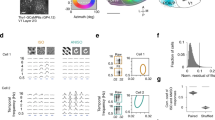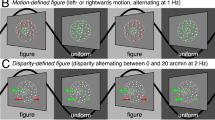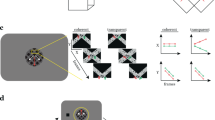Abstract
To analyse an image, the visual system must decompose the scene into its relevant parts. Identifying distinct surfaces is a basic operation in such analysis, and is believed to precede object recognition1,2. Two superimposed gratings moving in different directions (plaid stimuli) may be perceived either as two surfaces, one being transparent and sliding on top of the other (component motion) or as a single pattern whose direction of motion is intermediate to the component vectors (pattern motion)3,4,5,6. The degree of transparency, and hence the perception, can be manipulated by changing only the luminance of the grating intersections7,8,9,10,11,12. Here we show that neurons in two visual cortical areas—A18 and PMLS—synchronize their discharges when responding to contours of the same surface but not when responding to contours belonging to different surfaces. The amplitudes of responses correspond to previously described rate predictions3,13,14,15,16 for component and pattern motion, but, in contrast to synchrony, failed to reflect the transition from component to pattern motion induced by manipulating the degree of transparency. Thus, dynamic changes in synchronization could encode, in a context-dependent way, relations among simultaneous responses to spatially superimposed contours and thereby bias their association with distinct surfaces.
This is a preview of subscription content, access via your institution
Access options
Subscribe to this journal
Receive 51 print issues and online access
$199.00 per year
only $3.90 per issue
Buy this article
- Purchase on Springer Link
- Instant access to full article PDF
Prices may be subject to local taxes which are calculated during checkout




Similar content being viewed by others

References
Stoner, G. R. & Albright, T. D. The interpretation of visual motion: evidence for surface segmentation mechanisms. Vision Res. 36, 1291–1310 ( 1996).
Shimojo, S., Silverman, G. H. & Nakayama, K. An occlusion-related mechanism of depth perception based on motion and interocular sequence. Nature 333, 265–268 (1988)
Movshon, J. A, Adelson, E. H., Gizzi, M. & Newsome, W. T. in Study Group on Pattern Recognition Mechanisms (eds Chagas, C. Gatass, R. & Gross, C. G.) (Pontifica Academia Scientiarum, Vatican City, 1985).
Adelson, E. H. & Movshon, J. A. Phenomenal coherence of moving visual patterns. Nature 300, 523– 525 (1982).
Stoner, G. R., Albright, T. D. & Ramachandran, V. S. Transparency and coherence in human motion perception. Nature 344, 153–155 (1990)
Smith, A. T. & Harris, L. R. Use of plaid patterns to distinguish the corticofugal and direct retinal inputs to the brainstem optokinetic nystagmus generator. Exp. Brain Res. 86, 324– 332 (1991).
Metelli, F. The perception of transparency. Sci. Am. 230, 90–98 (1974).
Beck, J. & Ivry, R. On the role of figural organization in perceptual transparency. Percept. Psychophys. 44 , 585–594 (1988).
Albright, T. D. & Stoner, G. R. Visual motion perception. Proc. Natl Acad. Sci. USA 92, 2433–2440 (1995).
Stoner, G. R. & Albright T. D. Luminance contrast affects motion coherency in plaid patterns by acting as depth from occlusion cue. Vision Res. 38, 387–401 (1998).
Stoner, G. R. & Albright, T. D. Neural correlates of perceptual motion coherence. Nature 358, 412– 414 (1992).
Castelo-Branco, M. et al. MT/MST activation depends on the interpretation of stimuli: a functional fMRI study of the perception of plaids. Soc. Neurosci. Abstr. 23, 460 (1997).
Rodman, H. R. & Albright, T. D. Single-unit analysis of pattern-motion selective properties in the middle temporal visual area (MT). Exp. Brain Res. 75, 53–64 (1989).
Gizzi, M. S., Katz, E., Schumer, R. A. & Movshon, J. A. Selectivity for orientation and direction of motion of single neurons in cat striate and extrastriate visual cortex. J. Neurophysiol. 63, 1529–1543 (1990).
Scannell, J. W. et al. Visual motion processing in the anterior ectosylvian sulcus of the cat. J. Neurophysiol. 76, 895 –907 (1996).
Merabet, L., Desautels, A., Minville, K. & Casanova, C. Motion integration in a thalamic visual nucleus. Nature 396, 265–268 (1998).
Gray, C. M., Konig, P., Engel, A. K. & Singer, W. Oscillatory responses in cat visual cortex exhibit inter-columnar synchronization which reflects global stimulus properties. Nature 338, 334–337 (1989).
Engel, A. K., Konig, P., Kreiter, A. K. & Singer, W. Interhemispheric synchronization of oscillatory neuronal responses in cat visual cortex. Science 252, 1177– 1179 (1991).
Freiwald, W. A., Kreiter, A. K. & Singer, W. Stimulus dependent intercolumnar synchronization of single unit responses in cat area 17. NeuroReport 6 , 2348–2352 (1995).
Kreiter, A. K. & Singer, W. Stimulus-dependent synchronization of neuronal responses in the visual cortex of the awake macaque monkey. J. Neurosci. 16, 2381– 2396 (1996).
Brecht, M., Singer, W. & Engel, A. K. Correlation analysis of corticotectal interactions in the cat visual system. J. Neurophysiol. 79, 2394–2407 (1998).
Brecht, M., Singer, W. & Engel, A. K. Collicular saccade vectors defined by synchronization. Soc. Neurosci. Abstr. 23, 843 (1997).
Castelo-Branco, M., Neuenschwander, S. & Singer, W. Synchronization of visual responses between the cortex, lateral geniculate nucleus, and retina in the anesthetized cat. J. Neurosci. 18, 6395–6410 (1998).
Palmer, L. A., Rosenquist, A. C. & Tusa, R. J. The retinotopic organization of lateral suprasylvian visual areas in the cat. J. Comp. Neurol. 177, 237–256 (1978).
Perkel, D. H., Gerstein, G. L. & Moore, G. P. Neuronal spike trains and stochastic point processes. II. Simultaneous spike trains. Biophys. J. 7, 419–440 (1967).
König, P. A method for the quantification of synchrony and oscillatory properties of neuronal activity. J. Neurosci. Methods 54, 31–37 (1994).
Edwards, A. L. Multiple Regression Analysis and the Analysis of Variance and Covariance (W. H. Freeman, New York, 1985).
Batschelet, E. Circular Statistics in Biology (Academic, London, 1993 ).
Swindale, N. V. Orientation tuning curves: empirical description and estimation of parameters. Biol. Cybern. 78, 45–56 (1998).
Acknowledgements
We thank H. Klon-Lipok, P. Janson and S. Grimm for their technical assistance in electrode manufacture and histology. This research was sponsored by the Max-Planck-Gesellschaft. M.C.-B. was partially supported by the Gulbenkian Foundation and Programa Praxis, Portugal.
Author information
Authors and Affiliations
Corresponding author
Rights and permissions
About this article
Cite this article
Castelo-Branco, M., Goebel, R., Neuenschwander, S. et al. Neural synchrony correlates with surface segregation rules. Nature 405, 685–689 (2000). https://doi.org/10.1038/35015079
Received:
Accepted:
Issue Date:
DOI: https://doi.org/10.1038/35015079
This article is cited by
-
Arche-writing and data-production in theory-oriented scientific practice: the case of free-viewing as experimental system to test the temporal correlation hypothesis
History and Philosophy of the Life Sciences (2021)
-
A Review on Feature Binding Theory and Its Functions Observed in Perceptual Process
Cognitive Computation (2017)
-
Top-down influences on visual processing
Nature Reviews Neuroscience (2013)
-
Spectral fingerprints of large-scale neuronal interactions
Nature Reviews Neuroscience (2012)
Comments
By submitting a comment you agree to abide by our Terms and Community Guidelines. If you find something abusive or that does not comply with our terms or guidelines please flag it as inappropriate.


